Today, I pulled out a stack of clothing I’ve set aside over a period of months – a sweatshirt with a big hole in the elbow of one sleeve, sweatpants with a torn pocket, socks with holes. I was particularly proud of the almost invisible darning n the dark blue sock; the light grey sock - not so much. I didn’t have yarn that matched the soft grey color and the results are not nearly as pleasing. The comfy sweatshirt wasn’t ready to be thrown away or turned into cleaning rags. I wouldn’t say that the elbow patch is particularly pretty or artisanal but it’s acceptable and extends this garment’s use for a few more seasons.
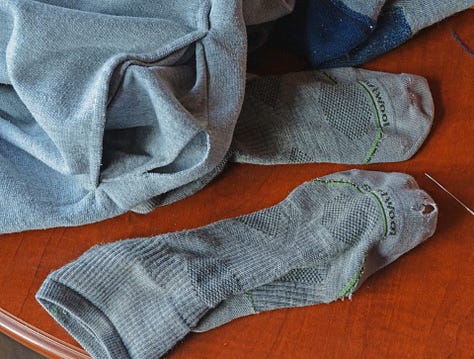
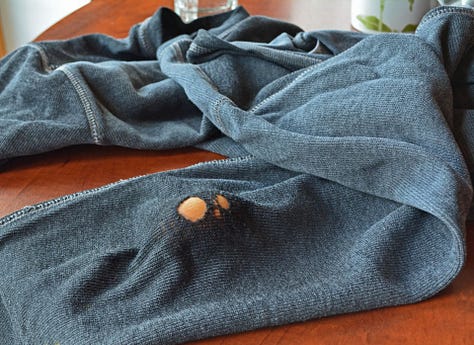
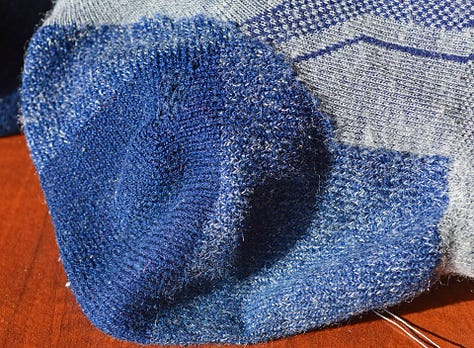
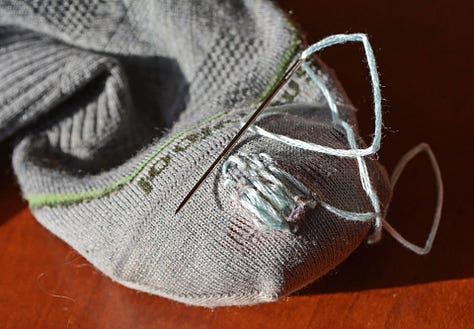
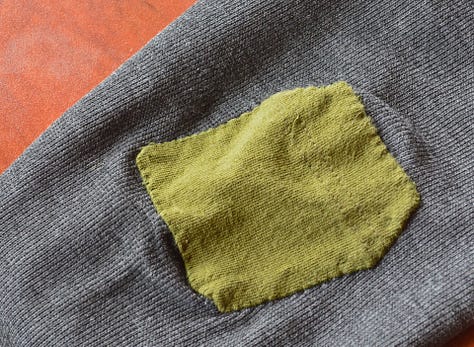
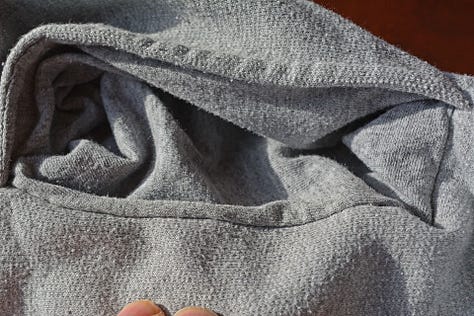
The following is an excerpt from the January chapter of my book, Seasons of A Wild Life. Each chapter holds an activity that helps us lighten our footprints.
Mending and Repair
Our ancestors spent wintertime mending quilts and articles of clothing, carding and spinning wool into yarn; cleaning, sharpening, and repairing tools; and crafting new clothing and tools. I imagine them sitting around the wood stove or fireplace sipping tea or spiced wine and working away in silence, bits of conversation bubbling up occasionally.
Even in our modern times, January remains a good month for repair work that has piled up through the year. I sew patches on Dan’s favorite work pants and jackets to give them a few more seasons of wear. As a bonus, these patches give him street credibility as a working man in our rural county. Local farmers, who barely exchanged a greeting for the first ten years of our time in the county, now are chatty with him. I think my patches may have had something to do with it.
Those of us raised in a planned-obsolescence economy often throw away products that are still perfectly good or that only require minor repair. These are just a few examples I gleaned from an employee at our local landfill: One man dropped off a brand-new raccoon trap complaining that it didn’t work. But the trap worked perfectly in the hands of someone who actually knew how to set it. Somebody else unloaded a refrigerator with a few dents on the outside but otherwise in perfect working condition. A floor fan only needed a bit of tinkering to be functional again.
Why do we repair, and what is the value of repair? In her book Repair, Elizabeth Spelman states: “To repair is to acknowledge and respond to the fracturability of the world.”1 Perhaps we restore a sense of wholeness, of how we think the world should be, when we repair something that is broken. Beyond the obvious benefits of restoring broken items, the habit of mending and repairing things has larger ripple effects.
I find myself slowing down when I make time to darn a hole in my favorite wool socks, sew a button back on a sweater, or turn an old bed sheet into handkerchiefs or bandanas. It allows me to think about the effort it took to source the basic materials these objects were made from, the people who were involved in crafting the products, and the people who taught me the skills to maintain and repair these objects with a sense of appreciation.
Mending and repairing are activities embedded in a larger worldview that values the interconnectedness of resources, humans, and environment. In an encouraging recent development, France has pioneered subsidies to businesses specializing in repairs to encourage French consumers to have their clothing and shoes mended professionally. This initiative aims to accomplish two goals: to preserve jobs requiring traditional craftsmanship and to extend the life of garments and footwear, which make up a substantial portion of landfill trash.2
Perhaps one of the most beautiful approaches to repairing objects that combines functionality and an underlying philosophy of life can be found in the Japanese custom kintsugi. Repair of a broken porcelain or pottery item is not accomplished by trying to hide the broken places but instead by embellishing and highlighting the mended places with gold. Kintsugi is an offspring of the Japanese philosophy of wabi-sabi, which finds beauty in imperfection as well as mottainai, which seeks to avoid wastefulness.3
There is great satisfaction in making something whole again, and it may just transfer to other areas of our lives that need restoration and healing: relationships, watersheds, abandoned lots.4
What will you try to fix this month waiting to thaw out from snow and ice?
Notes:
1 Elizabeth V. Spelman, Repair: The Impulse to Restore in a Fragile World (Boston: Beacon, 2002), 5.
2The Daily Difference Newsletter, “News from France in the Fight against Fashion Waste,” The Carbon Almanac, June 28, 2023, https://thecarbonalmanac.org/news-from-france-in-the-fight-against-fashion-waste/.
3 Kelly Richman-Abdou, “Kintsugi: The Centuries-Old Art of Repairing Broken Pottery with Gold,” My Modern Met, March 5, 2022, https://mymodernmet.com/kintsugi-kintsukuroi/.
4 Nina and Sonya Montenegro, Mending Life: A Handbook for Repairing Clothes and Hearts (Seattle: Sasquatch Books, 2020).






Since most of our socks are handmade, I spend a couple of lovely afternoons darning every once in a while. And I love the idea of cutting up sheets for handkerchiefs. ❤️
I love this. There are too many clothes in the world. I cut up irredeemable clothes for rags. They are great when used with a bidet toilet attachment and really came in handy during the great toilet paper shortage!